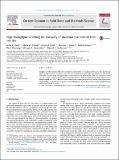| dc.contributor.author | Celiz, Adam D. | |
| dc.contributor.author | Davies, Martyn C. | |
| dc.contributor.author | Denning, Chris | |
| dc.contributor.author | Alexander, Morgan R. | |
| dc.contributor.author | Tibbitt, Mark W | |
| dc.contributor.author | Langer, Robert S | |
| dc.contributor.author | Anderson, Daniel Griffith | |
| dc.contributor.author | Patel, Asha | |
| dc.date.accessioned | 2017-03-06T16:05:06Z | |
| dc.date.available | 2017-03-06T16:05:06Z | |
| dc.date.issued | 2016-01 | |
| dc.date.submitted | 2015-12 | |
| dc.identifier.issn | 1359-0286 | |
| dc.identifier.uri | http://hdl.handle.net/1721.1/107190 | |
| dc.description.abstract | Insights into the complex stem cell niche have identified the cell–material interface to be a potent regulator of stem cell fate via material properties such as chemistry, topography and stiffness. In light of this, materials scientists have the opportunity to develop bioactive materials for stem cell culture that elicit specific cellular responses. To accelerate materials discovery, high throughput screening platforms have been designed which can rapidly evaluate combinatorial material libraries in two and three-dimensional environments. In this review, we present screening platforms for the discovery of material properties that influence stem cell behavior. | en_US |
| dc.description.sponsorship | Engineering and Physical Sciences Research Council | en_US |
| dc.description.sponsorship | National Institutes of Health (U.S.) (Ruth L. Kirschstein National Research Service Award F32HL122009) | en_US |
| dc.description.sponsorship | National Institutes of Health (U.S.) (Grant R01 DE016516) | en_US |
| dc.language.iso | en_US | |
| dc.publisher | Elsevier | en_US |
| dc.relation.isversionof | http://dx.doi.org/10.1016/j.cossms.2016.02.002 | en_US |
| dc.rights | Creative Commons Attribution 4.0 International License | en_US |
| dc.rights.uri | http://creativecommons.org/licenses/by/4.0/ | en_US |
| dc.source | Elsevier | en_US |
| dc.title | High throughput screening for discovery of materials that control stem cell fate | en_US |
| dc.type | Article | en_US |
| dc.identifier.citation | Patel, Asha K. et al. “High Throughput Screening for Discovery of Materials That Control Stem Cell Fate.” Current Opinion in Solid State and Materials Science 20.4 (2016): 202–211. | en_US |
| dc.contributor.department | Harvard University--MIT Division of Health Sciences and Technology | en_US |
| dc.contributor.department | Massachusetts Institute of Technology. Department of Biological Engineering | en_US |
| dc.contributor.department | Massachusetts Institute of Technology. Department of Chemical Engineering | en_US |
| dc.contributor.department | Koch Institute for Integrative Cancer Research at MIT | en_US |
| dc.contributor.mitauthor | Patel, Asha K | |
| dc.contributor.mitauthor | Tibbitt, Mark W | |
| dc.contributor.mitauthor | Langer, Robert S | |
| dc.contributor.mitauthor | Anderson, Daniel Griffith | |
| dc.relation.journal | Current Opinion in Solid State and Materials Science | en_US |
| dc.eprint.version | Final published version | en_US |
| dc.type.uri | http://purl.org/eprint/type/JournalArticle | en_US |
| eprint.status | http://purl.org/eprint/status/PeerReviewed | en_US |
| dspace.orderedauthors | Patel, Asha K.; Tibbitt, Mark W.; Celiz, Adam D.; Davies, Martyn C.; Langer, Robert; Denning, Chris; Alexander, Morgan R.; Anderson, Daniel G. | en_US |
| dspace.embargo.terms | N | en_US |
| dc.identifier.orcid | https://orcid.org/0000-0002-7266-9251 | |
| dc.identifier.orcid | https://orcid.org/0000-0002-4917-7187 | |
| dc.identifier.orcid | https://orcid.org/0000-0003-4255-0492 | |
| dc.identifier.orcid | https://orcid.org/0000-0001-5629-4798 | |
| mit.license | PUBLISHER_CC | en_US |
